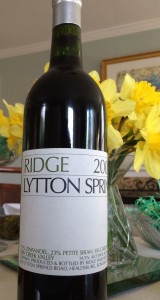Keep peeling that onion!
July 25, 2023 by John BrownWhen I was a teenager and knew everything there was to know about life, my father, in an attempt to enlighten me said, “Son, life is like an onion, there’s a lot of layers to it, and sometimes it will bring a tear to your eye, but you’ll be a wise man if you just keep on peeling.”
I just looked up at my dad with a blank stare and thought to myself: what the hell is he talking about? Of course, I didn’t verbalize what I was thinking. I simply nodded and continued to bungle my way through a decade of dissipation. And soon thereafter, I realized that I had just peeled back a layer of that onion and I wasn’t at all pleased with what I was seeing. I could only hope the next layer would reveal a wiser man.
I know what you’re thinking: ‘where the heck is HE going with this, and what does it have to do with wine?’
Hey, you’ll just have to be patient with me because I’m about to peel back another layer! And this layer reveals an undeniable truth: enjoying wine involves a fairly simple process. All you need to do to is put the wine in your mouth. If that simple experience is pleasant, then you’re probably happy. But to really get the maximum pleasure out of wine, you will need to peel back a little more of the onion.
That means finding the attributes that make exceptional wine, and that process is not simple. It’s complex and it can be challenging, but it’s also a lot of fun. I’m talking about searching for and finding wine that is more than just a pleasant quaff. A bottle that has unique and pleasing aromas, beautiful color and clarity, and one that also features incredible layers of flavor. The search for and discovery of such a bottle is the essence of wine appreciation. And while the journey may be long, it’s always pleasurable and extremely educational. Today’s primer will involve ways of finding the best possible red wine.

While I enjoy single varietal reds like pinot noir and cabernet sauvignon, I don’t think they have as much potential to produce the multi-layered, complex wine that bottles made from blends of grapes can. The greatest reds, like wines from Bordeaux, are blends of several grape varietals, including cabernet sauvignon, merlot, cabernet franc, malbec and petit verdot. Chateauneuf-du-Pape and the other red wines of the Rhone Valley in France can be made with as many as 13 varietals. The most common blends there are syrah, grenache and mourvèdre which many refer to as “The Holy Trinity.”
In the Napa Valley, one of the greatest red wines is Joseph Phelps Insignia. The 2018 Insignia is a blend of 87 percent cabernet sauvignon, 8 percent petit verdot, 2 percent malbec and 2 percent cabernet franc. One of the most expensive and prestigious wines in Napa, Opus One, is also a blend of five red Bordeaux-grapes.
I am a big fan of zinfandel and I love it as a single varietal. However, I really think it’s better when it’s blended with other grapes. Ridge Vineyards is my go-to zin producer in California, but my favorite wines produced at the winery are Geyserville and Lytton Springs which, depending upon the year, can be blends of zinfandel, petite syrah, mourvèdre and carignane.
Of course, when you pair that exceptionally complex wine with an equally special meal, you’ve found culinary nirvana. So, enjoy the journey and hopefully you’ll find that extraordinary bottle out there somewhere. All you have to do is keep peeling that onion.
John Brown is also a novelist. His latest book, Augie’s World, is a sequel to his debut novel, Augie’s War. Both novels are available in print and audio at Amazon. You can find out more about his novels and wine columns at wordsbyjohnbrown.com

